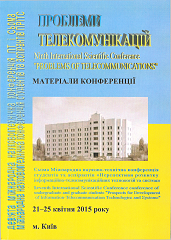МОДИФІКОВАНИЙ АЛГОРИТМ GABRIEL GRAPH - ПЛАНАРИЗАЦІЇ ДЛЯ ГЕОГРАФІЧНОЇ МАРШРУТИЗАЦІЇ В MANET МЕРЕЖАХ
Анотація
Modified Gabriel Graph planarization algorithm
for geographic routing in MANET networks
Most of modern geographic routing protocols use certain kind of network planarization algorithm to generate (and maintain) the network planar graph. The main and only purpose of such graph in geographic routing process is to implement face routing in the dead end situation (when transmitting node does not aware of any node closer to the destination than itself). This work is designed to provide a better algorithm of network planarization based on GG-planarization and check its behavior depending on various network parameters such as nodes transmission range rate (ratio of max range to min range) and average node degree in the network graph.
Посилання
KARP, B., AND KUNG, H. T. GPSR: Greedy perimeter stateless routing for wireless networks. In Proc. ACM/IEEE MobiCom (Boston, Mass., USA, Aug. 2000).
Kim, Y-J; Govindan, R; Karp, B; Shenker, S; (2006) Lazy Cross-Link Removal for Geographic Routing. In: SenSys '06: Proceedings of the 4th international conference on embedded networked sensor systems. (pp. 112 - 124).
[Електронний ресурс] http://itsve.tk/off/pt2015.
##submission.downloads##
Як цитувати
Номер
Розділ
Ліцензія
Авторське право (c) 2017 Ігор Олегович Цветков

Ця робота ліцензується відповідно до Creative Commons Attribution 4.0 International License.
Authors who submit to this conference agree to the following terms:a) Authors retain copyright over their work, while allowing the conference to place this unpublished work under a Creative Commons Attribution License, which allows others to freely access, use, and share the work, with an acknowledgement of the work's authorship and its initial presentation at this conference.
b) Authors are able to waive the terms of the CC license and enter into separate, additional contractual arrangements for the non-exclusive distribution and subsequent publication of this work (e.g., publish a revised version in a journal, post it to an institutional repository or publish it in a book), with an acknowledgement of its initial presentation at this conference.
c) In addition, authors are encouraged to post and share their work online (e.g., in institutional repositories or on their website) at any point before and after the conference.

